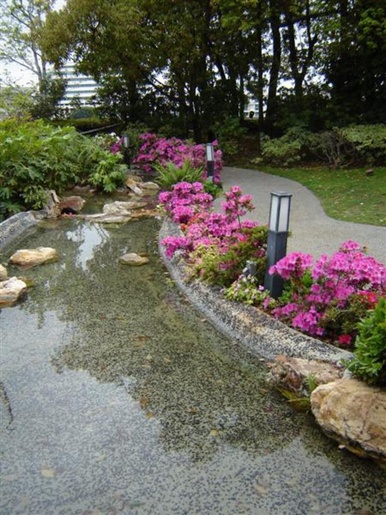

Landscaping America: Occidental College Student Research
 mpitelka
mpitelka
|

|
||
| Licensing | ||
The New Otani Japanese Garden
Images from the Japanese Garden on the roof of the New Otani Hotel in Los Angeles.
By Christy Moloney: Taking in the garden at the New Otani Hotel in Little Tokyo is strange given that it is located in the heart of downtown Los Angeles. The garden itself sits on the top floor of one part of the hotel while what appears to be a new addition soars high above it another dozen or so stories. The sky-scraperlike hotel that the garden sits atop and next to is very similar to the other concrete buildings surrounding the hotel. The effect is almost nostalgic, as if the hotel managers and gardeners that constructed this little piece of forcedJapaneseness were trying to construct a paradise to escape to. But as my group members and I felt, the garden atop the New Otani is an inclination toward authenticity and disenchantment that only left us unconvinced.
The cherry blossoms that Emiko Ohnuki Tierney asserted as representing the Japanese soul are obvious in their presence all over the small rooftop garden, as are stone lanterns, waterfalls, and bonsai shrubs. However, the simplicity and tranquility found in real Japanese and Japanesestyle gardens is, to me, conspicuously absent. The garden has several focal points that disallow the visitor to really focus on any one small area of beauty. Instead, the eyes flitter about everywhere searching for a calm place to rest.
When one’s eyes can finally regain focus, they most likely have fallen on a quiet corner of the garden that sits parallel to the hotel’s sushi bar. In a shallow pond sits a stone lantern, several rocks, and a wooden platform. Atop the platform is a simple bench to sit on and gaze out upon the rest of the garden. In the Western commercial cannon, this is probably referred to as the “Zen Corner” in which visitors can meditate and reflect in peace. Although, if one is expected to sit in the garden’s one unostentatious place and look out upon the chaos known as the rest of the garden, they most likely will not attain inner tranquility.
Kendall Brown wrote of immigrants trying to find a cultural home in an anxiety-causing place, and Los Angeles can certainly be seen as a place of social dislocation. In Territories of Play: A Short History of Japanese-Style Gardens In North America, Brown also discussed how claiming identity was important for immigrants and how Japanese-style gardens were one way in which the Japanese in America could still feel Japanese. Gardens across the country were used in tea ceremonies, cultural festivals and other symbolic recreational activities, and continue to serve such functions today. But I cannot imagine the garden of the New Otani hosting any serious cultural activity as the Huntington Garden does. A private cocktail party perhaps, but not a ceremony commemorating the Emperor’s birthday; this is partially due to the garden’s extremely small size, but mainly because of its cheap masquerade as a garden of symbolic substance.
Perhaps more disturbing than the garden’s failed attempts toward achieving any semblance of authenticity is the reaction of Westerners toward the garden as being a fair representation of Japaneseness. Case in point, while my group and I were on our visit, we encountered a sole gentleman taking in the garden at the same time as us. He appeared to be in his 50s, white, and American, complete with a grande Starbucks coffee. Said individual sat in a patio chair and quietly drank his coffee and looked out upon the various parts of the garden. He was so deep in his serene trance that he did not even notice us taking photos of him or giggling about the Japanophile in our midst, in his natural habitat. He was there when we arrived and remained for who knows how long after we made our departure. Maybe he was a guest at the hotel and wanted some fresh air with his afternoon coffee. Or maybe he heard about the garden and wanted to see it for himself. Conceivably, he could have been an Asian studies expert and was there to critique the garden, but more likely than not he was just another American white man of privilege, absorbing the Japanese-style garden as a valid portrayal of the Other. As race and sex politics theorist bell hooks wrote, this man was “eating the Other” in his consumption of the New Otani’s garden as a rare and special entity he had never before encountered. Since he presumably knew nothing about the garden, or anything about Japanese-style gardens for that matter, the man was taking in the garden as an exotic experience. It is creepy to think about it like this, as if the man was some evil being devouring the Other and, in some ways, becoming the Other through this consumption. Of course, the man is not consciously this thing, but he still may be playing that role without knowing it.
As Brown said, Japanese gardens are supposed to be artificial by nature, given the consideration to stunting and manipulating growth of bonsai and arranging rocks in perfectly unnatural ways. But the garden of the New Otani is tawdry in its farfetched attempt at being genuinely Japanese in any way.
To see more images, click on "View Original Item" below. Then click on "View Collection."
By:
Christy Moloney
Laura Wong
Scott Hampton
Kai Mammoser
Based on this original

|
New Otani Garden |
 kmammoser
kmammoser
 Little Tokyo Community Profiles
Little Tokyo Community Profiles Landscaping America: Occidental College Student Research
Landscaping America: Occidental College Student Research Japanophilia
Japanophilia
 Journal feed
Journal feed
